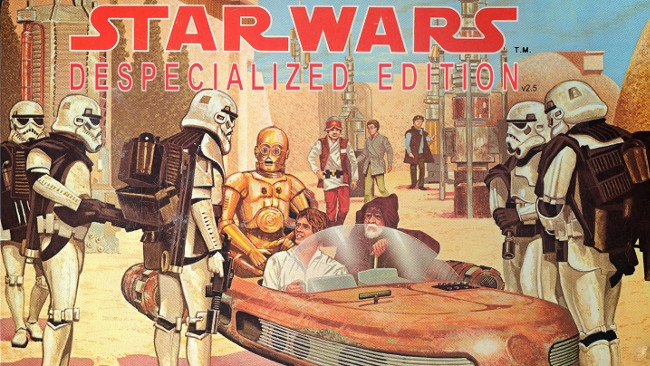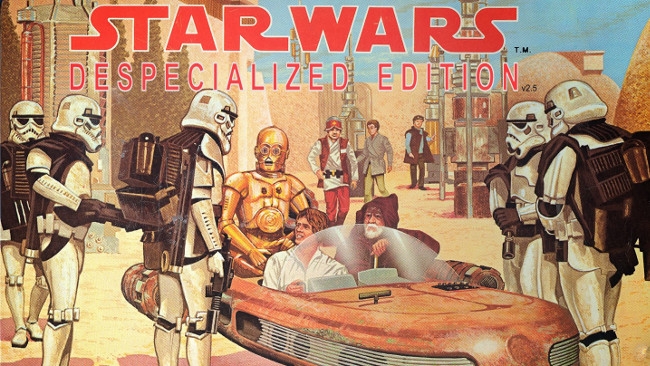
 Star Wars Despecialized
Star Wars Despecialized
A fan-led effort has worked to restore the original Star Wars trilogy to its unaltered glory, but how long will we have to wait for an official re-release? By Joe Foster.
The Industry is generally thought of as being forward thinking and forward moving. Technology moves at such a rapid speed that most can barely keep up. Although there are some who refuse to move in new directions (see the little known Digital vs. Film debate, which you have probably heard of), technology generally moves forward and the industry mostly follows (not quite like a pied piper, but not too far off either). Despite this, there is a rather unique example of new technology being used to move backwards.
I recently came across an ongoing project, known as Star Wars: The Despecialized Edition. Surprisingly, this is not another home release by Lucas' empire to capitalize on the wallets of hungry fans. Instead, it's an attempt to utilize modern technology to create a cut of the original films that's as close to the original theatrical releases as humanly possible – or to 'Despecialize' the loathed Special Editions. It's taken a lot of man-hours and several versions and the (sort of) final results are impressive to say the least.
The Story So Far….
Since I've now listened to my family and friends and realized that not everyone is a Star Wars nut like me, there might very well be some confusion as to why such a project exists, why it matters to a great deal of people and why these are not official releases.
Let me start at the beginning for the uninitiated. George Lucas' popular space opera has actually been a source of controversy to its fans and they have not been the happiest folks around, despite having the ability to watch the films as much as they like and having brilliant replica lightsabers available to buy.
Lucas started the process of restoring and updating his much loved space saga at great expense in the mid-nineties (it is estimated to have cost about $15 million to complete the project - $10 million of which was just on the first film) and released them in 1997 for the 20th Anniversary of the original release. These reworked films were dubbed 'The Star Wars Trilogy Special Edition' and fans have been reeling ever since. There are technically three special editions that exist for home release, with new fan agitating changes and alterations. These are the 1997 original release, the 2004 first DVD and the 2011 Blu-Ray (I could go into greater detail about the differences between these and the various VHS and laserdisc releases, but there would be a risk of a severe intergalactic headache).
George Lucas and his team have produced version after version, alterations after alterations and new editions after new editions of the original Star Wars trilogy. Many have these changes have driven fans bonkers and sent them crying artistic and historical blasphemy. The changes were numerous; some were subtle (lighting and colour palate alterations, retimed sequences), but some were glaring and stuck out like a computer generated sore thumb (extra aliens and creatures filling the foreground and background, updated spaceship sequences and the controversial 'Han shot first' debacle). There is a CGI sequence here, a replaced audio there and even blinking Ewoks (not as an adjective before a noun, they actually do blink in the Blu-Ray releases). The reasons for the various alterations have been numerous, from 'artistic reasons' to Lucas being unsatisfied with certain special effect sequences that were troublesome to create in the 70's and 80's. Even a deleted scene from the first Star Wars movie involving the villainous crime lord Jabba the Hut that was abandoned for budget, logistical and technological reasons was restored, completed and added to the new cut.
For decades, fans have been craving the holy grail of Star Wars home releases – the original, unaltered editions of the original Star Wars trilogy as it was shown in theatres, special effect warts and all, as they originally experienced it. Petitions, forums, documentaries and websites have been created purely for that dream. Unfortunately, Lucas has been adamant about not releasing or even considering such a product. In a 2004 interview he stated, "It's like this is the movie I wanted it to be and I'm sorry if you saw half a completed film and fell in love with it, but I want it to be the way I want it to be." His reluctance to release such a version has sparked debates on artist vs. audience ownership and even a refusal by Lucas to submit the Oscar-winning original to National Film Registry for preservation.
Some fans got tired of the Lucas Empire not adhering to such demands, and so the fan community of originaltrilogy.com started working on a version of its very own…
The Rebels Strike Back
These disgruntled fans created the 'Despecialized Editions'. Unofficially headed by Czech Republic Star Wars devotee Petr Harmáček (more widely known as 'Harmy'), various technical sources were utilized to create the closest approximation to the original theatrical trilogy possible. The main source is the 2011 Blu-Ray home release (which itself comes from the 2004 DVD masters, albeit with extra blinking Ewoks amongst other changes), and this rebel alliance of devotees used various other sources to rotoscope old effects, restore matte paintings and use as colour correction references (the newer versions were criticized for being a little too far on the magenta side and problems with crushed blacks in the darker areas).
They used the best-known copies of the original versions. One of these was the 'GOUT' (George's Original Unaltered Trilogy) version. This was an attempt by Lucasfilm in 2006 to silence the demands and complaints and release the original versions on DVD; however the 'original' source was from a 1993 laserdisc master and had a number of issues. These include a lower quality picture (including faded or washed out colours and contrast), aliasing, obvious digital noise removal that caused ghosting effects and a non-anamorphic presentation. Despite these problems, it is one of the best quality versions of the original trilogy officially available and was one of the main sources of the project. Other sources include an original HDTV broadcast, an anamorphic SD digital broadcast master tape and even film sources – including an Italian 16mm print and a grainy LPP 35mm print - which was analyzed with a homemade film scanner. Various elements from these different sources were either constructed into a single picture and whole up-scaled shots were added to the final cut. All of these elements combined into a single seamless edit.
The video at the end of this article highlights these rebellious fan's intentions and the processes they used with examples. It's a really fascinating glimpse into technology being used in a slightly different way to the norm and it's quite lovely to see how devoted some people can be to cinematic history and art. Its also incredibly impressive how they were able to achieve their goals using a variety of less-than ideal sources. What's even more remarkable is the fact that this didn't cost anywhere close to the $15 million Lucas spent.
A Different Kind of Clone
Star Wars is not the only sci-fi franchise with a passionate following to receive an upgrade. Back in 2006, Paramount had announced that they were working to upgrade and remaster the original (and much beloved) sixties series of Star Trek for everyone's (then) shiny new HD televisions. Based on the negativity surrounding the CGI tinkering of the original Star Wars movies from before, hardcore Trekies/Trekers were understandably weary and skeptical. Even fan favourite Leonard Nimoy was highly critical of the idea.
Then a funny thing happened when the shows were broadcast, the geek/nerd community was mostly silent. There was no fan protesting, no websites dedicated to hating the changes or petitions drawn up to have them removed. Some even praised the newer versions – even Mr Nimoy changed his mind when he saw them for the first time. I had always found it curious why such passionate and dedicated fans had accepted one remaster, but not another. Both are just as passionate as the other (I count myself as both), so why was there no war declared or rebel alliance formed?
I now believe there are three answers to this question. The first is subtlety. The CGI effects are a few polishes here, a few colour corrections there, and some enhancements of matte paintings. There are no random CGI characters running across the screen or making silly noises. The second is respect. Even the more glaring changes (such as the exterior ship shots) are done in an oddly sixties style. You almost believe that if that same technology was available at that time, this is what it would have looked like. The designs of the ships weren't changed; they still seem to move in a similar fashion to their model counterparts – only far cleaner looking and in lovely HD. There is a sense that the more subtle corrections were done out of respect, rather than a disdain for the originals. The third reason is by not erasing the past. Even if there are those who cry foul to the alterations (and they are indeed out there – these are Sci-Fi fans we're talking about after all), both versions are available on DVD and the Blu-Ray releases have the ability to switch between the two. If you want to see the old dodgy model effects, you're perfectly free to do so. No dusty VHS tapes required.
The third reason is, in my humble opinion, the most crucial. Remasters and clean-ups definitely have their benefits, but why not have both versions available? This is where Lucas truly got it wrong, not for the enhancements to his art, but perhaps for forcing audiences to agree with him – to share his ill feelings for the originals and how they were done. Unfortunately, too many were already smitten and clearly still in love.
If you're at all interested, check out some stills comparing the original with the remaster of the Star Trek episode 'Amok Time' HERE.
Disney Allies?
All this does beg the question of why Disney, after its recent acquisition of the Star Wars franchise, hasn't released the original cleaned-up films themselves – something that the fans are truly craving and would pay top dollar for. After all, the relatively low cost to the Mouse House versus the potential profit return makes this a rather attractive proposition. The enormous task of cleaning up of the original film negatives (which sadly were in a poor state when Lucas first started his tinkering) was already done back in the mid-nineties and the technology in Disney's arsenal would certainly make the task even more possible.
Sadly, the major hurdle with Disney accomplishing this is the permanent distribution rights for the first film being held solely by 20th Century Fox. It's reasonable to think that this can be worked out, but it's still a legal nightmare.
There are rumors that Disney is planning to release what the majority of fans have been fighting for all this time. Only time will tell if the rebel's efforts have been worth it.
Tags: Business


Comments